
The Russian alphabet is the script used to write the Russian language. It comes from the Cyrillic script, which was devised in the 9th century for the first Slavic literary language, Old Slavonic. Initially an old variant of the Bulgarian alphabet, it became used in the Kievan Rusʹ since the 10th century to write what would become the modern Russian language.
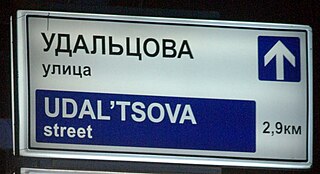
The romanization of the Russian language, aside from its primary use for including Russian names and words in text written in a Latin alphabet, is also essential for computer users to input Russian text who either do not have a keyboard or word processor set up for inputting Cyrillic, or else are not capable of typing rapidly using a native Russian keyboard layout (JCUKEN). In the latter case, they would type using a system of transliteration fitted for their keyboard layout, such as for English QWERTY keyboards, and then use an automated tool to convert the text into Cyrillic.
The Azerbaijani alphabet has three versions which includes the Arabic, Latin, and Cyrillic alphabets.

Izhitsa is a letter of the early Cyrillic alphabet and several later alphabets, usually the last in the row. It originates from the Greek letter upsilon and was used in words and names derived from or via the Greek language, such as кѵрилъ or флаѵии. It represented the sounds or as normal letters и and в, respectively. The Glagolitic alphabet has a corresponding letter with the name izhitsa as well. Also, izhitsa in its standard form or, most often, in a tailed variant was part of a digraph оѵ/оу representing the sound. The digraph is known as Cyrillic "uk", and today's Cyrillic letter u originates from its simplified form.

Elena A. Bacaloglu, also known as Bakaloglu, Bacaloglu-Densusianu, Bacaloglu-Densușeanu etc., was a Romanian journalist, literary critic, novelist and fascist militant. Her career in letters produced an introduction to the work of Maurice Maeterlinck (1903), several other critical essays, and two novels. She married and divorced writer Radu D. Rosetti, then Ovid Densusianu, the Symbolist poet and literary theorist.
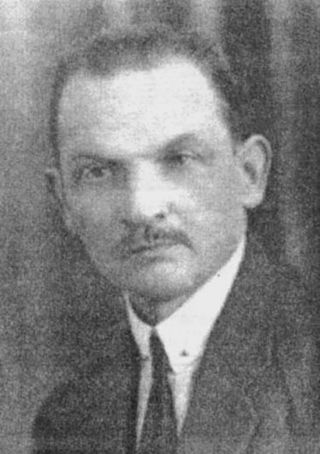
Alexis Nour was a Bessarabian-born Romanian journalist, activist and essayist, known for his advocacy of Romanian-Bessarabian union and his critique of the Russian Empire, but also for controversial political dealings. Oscillating between socialism and Russian nationalism, he was noted as founder of Viața Basarabiei gazette. Eventually affiliated with Romania's left-wing form of cultural nationalism, or Poporanism, Nour was a long-term correspondent of the Poporanist review Viața Românească. Publicizing his conflict with the Russian authorities, he settled in the Kingdom of Romania, where he openly rallied with the Viața Românească group.
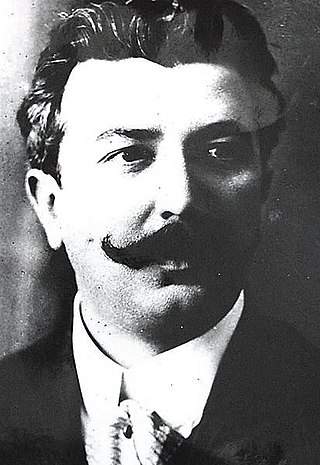
George or Gheorghe Ranetti, born George Ranete, was a Romanian poet, journalist and playwright, known as the founder and editor of Furnica magazine. A professional journalist from the late 1890s, he alternated between political dailies and literary reviews, being sympathetic to Romanian nationalism and traditionalism, and working under Ion Luca Caragiale at Moftul Român. By 1904–1906, he was active on the margin of left-wing traditionalism, or Poporanism, showing himself sympathetic to republican or generically anti-elitist ideologies. Such views and influences seeped into his activity at Furnica, which was for decades a prominent institution in Romanian humor.
Aladar Imre, also known as Pavel Corneliu, was a Romanian trade unionist, communist militant and member-elect of the Romanian Parliament, executed in the Soviet Union during the Great Purge.

Bucura Dumbravă, pen name of Ștefania "Fanny" Szekulics, Szekulicz or Seculici, was a Hungarian-born Romanian genre novelist, cultural promoter, hiker and Theosophist. Her literary work, mainly written in German, covers romantic stories about the legendary feats of hajduk heroes. They brought her commercial success in both German-speaking Europe and Romania, and were prefaced by Queen-consort Elisabeth of Wied.
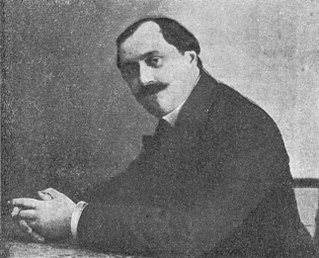
Dumitru or Dimitrie Karnabatt was a Romanian poet, art critic and political journalist, one of the minor representatives of Symbolism. He was a disciple of both Alexandru Macedonski and Ștefan Petică, representing the conservative and mystical school of Romanian Symbolism, and a regular contributor to the newspaper Seara. He is also remembered as the husband and, for a while, literary partner of novelist Lucrezzia Karnabatt.
Volkswille, later renamed Arbeiter-Zeitung, was a German language newspaper published from Temesvár/Timișoara between 1893 and 1933. Volkswille was the main organ of the German-speaking labour movement in the Banat region. It was the sole long-lasting German-language socialist newspaper in the region.
Proletarul ('Proletarian') was a socialist newspaper published from Botoșani, Kingdom of Romania. The newspaper began publishing on 1 March (O.S.) (13 March ), 1892. It was the organ of the Workers Club of Botoșani. It was managed by an editorial committee. Amongst the contributors to Proletarul were Dr. Panait Zosin and Henric Sanielevici. It was published twice monthly, the typography was done as Goldșleger & Comp.
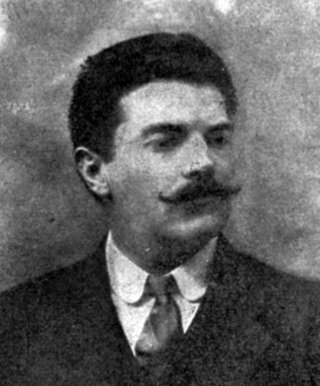
Donar Munteanu was a Romanian poet, representing the provincial wing of Romanian Symbolism, Convorbiri Critice circle and, later, the Gândirea literary movement. Generally considered a good, but not great, author, from his thirties and into old age he belonged to the devotional school of Orthodox Church writers, producing mostly sonnets. Professionally, he was active as a magistrate and prison inspector, a career which allowed him to visit the country and to participate in the literary life of Bessarabia. He withdrew from public life following the establishment of Romanian communist regime, and remained largely forgotten.

Paul Zarifopol was a Romanian literary and social critic, essayist, and literary historian. The scion of an aristocratic family, formally trained in both philology and the sociology of literature, he emerged in the 1910s as a rebel, highly distinctive, voice among the Romanian press and book reviewers. He was a confidant and publisher of the Romanian writer Ion Luca Caragiale, building his theories on Caragiale's already trenchant appraisals of Romanian society and culture. Zarifopol defended art for art's sake even against the Marxism of his father-in-law, Constantin Dobrogeanu-Gherea, and the Poporanism of his friend, Garabet Ibrăileanu. He was also a noted censurer of neoclassical trends, of philistinism, and of inauthentic customs, advocating renewal, but not revolution. A skeptic reviewer of modernist literature, he reemerged during the interwar period as its dedicated promoter, but his preference for literary entertainment over substance and many of his literary bets were shortly dismissed by other experts of the day.
Constantin Gheorghe Banu was a Romanian writer, journalist and politician, who served as Arts and Religious Affairs Minister in 1922–1923. He is remembered in literary history as the founder of Flacăra review, which he published in two editions, alongside Petre Locusteanu, Ion Pillat, Adrian Maniu, and, later, Vintilă Russu-Șirianu. A best-selling magazine for its time, it functioned as a launching pad for several writers of the Romanian Symbolist movement.

Leon Feraru was a Romanian and American poet, literary historian and translator. Cultivating proletarian literature while frequenting the Symbolist movement, he displayed both his origins in the Romanian Jewish underclass and his appreciation for the wider Romanian culture. He popularized the latter with his work in America, having left in 1913 to escape antisemitic pressures. A translator, publicist, and public lecturer, he was involved with the Romanian press of New York City, and eventually as a Romance studies academic at Columbia and Long Island. Feraru's poetry, collected in two volumes, mixes Romanian patriotism, traditionalist references, and modern industrial aesthetics.

Radu D. Rosetti or Rossetti was a Romanian poet, playwright, and short story writer, also distinguished as an attorney and activist. The son of playwright-aristocrat Dimitrie Rosetti-Max and nephew of Titu Maiorescu, he had a troubled and rebellious youth, split between Romania and Austria-Hungary; during these debut years, he kept company with senior literary figures such as Ion Luca Caragiale and Alexandru Vlahuță. Graduating from the University of Bucharest at age 26, he was already a successful poet of neoromantic sensibilities, a published translator of plays and novels, and also famous for his unhappy marriage to the literary critic Elena Bacaloglu. Rosetti then switched to writing social-themed plays and stories of his professional life, earning a high profile as a defender of left-wing causes and impoverished clients. He traveled extensively and to exotic locations, publishing a number of volumes detailing his experiences.

Pyotr Zakharovich Bazhbeuk-Melikov, also Bachbeouk-Melikoff, Bazhbeuk-Melikyan or Bazhbeuk-Melikishvili, was an ethnic Armenian politician and agronomist in Bessarabia. Educated in Tiflis Governorate and then in France, he had various administrative offices in the Russian Empire and the Russian Republic. He presented himself in the November 1917 election for the Russian Constituent Assembly as an affiliate of the Constitutional Democratic Party. Failing in this bid, Bazhbeuk was instead welcomed as an Armenian delegate by the Bessarabian assembly, or Sfatul Țării, just before the proclamation of a Moldavian Democratic Republic. Loyal toward the latter, he spoke out against Bolshevik infiltration, and asked for an intervention by the neighboring Kingdom of Romania. Though he welcomed the Romanian military expedition of early 1918, he found himself opposed to the subsequent union between Bessarabia and Romania, reverting to Russian monarchism.
Events from the year 1934 in Romania. The year saw the country sign the Balkan Pact.
Modern Romanian is the historical stage of the Romanian language starting from the end of the 18th century until today. In general, it is agreed that the modern era comprises three distinct periods: the premodern period starting from 1780 and lasting until 1830, the modern period from 1830 until 1880, and the contemporary period after 1881. Some researchers place the end of this last category roughly after the Second World War and the "Socialist Period", thus separating the current state of the Romanian language from a different era. Modern Romanian is characterized by the development of the Romanian alphabet and modern system of writing, initial Latin and Italian lexical item entries, followed by the central role of French in the development of the Romanian lexis, the development of literary styles, and standardization of the language.





















